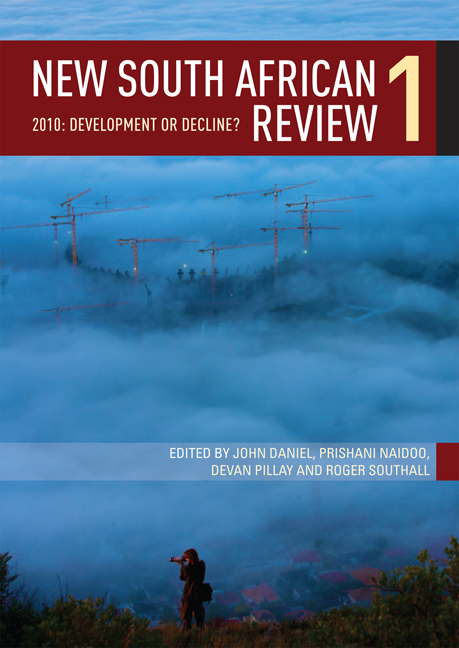Book contents
- Frontmatter
- Contents
- Preface
- Introduction South Africa 2010: From short-term success to long-term decline?
- PART 1 ECONOMY, ECOLOGY AND SUSTAINABILITY
- PART 2 STATE, POLITICS AND POLICY
- PART 3 EDUCATION, HEALTH AND LAND
- INTRODUCTION Reform and redress in higher education, health and land
- CHAPTER 11 ‘Silencing and worse …‘: The humanities and social sciences in South Africa
- CHAPTER 12 Realising transformation, equity and social justice in higher education
- CHAPTER 13 The polarising impact of South Africa's AIDS epidemic
- CHAPTER 14 Health for all? Towards a national health service in South Africa
- CHAPTER 15 The Comprehensive Rural Development Programme (CRDP): A beacon of growth for rural South Africa?
- CHAPTER 16 Breaking down barriers: Policy gaps and new options in South African land reform
- PART 4 Doreen Atkinson
- Contributors
- Index
CHAPTER 13 - The polarising impact of South Africa's AIDS epidemic
from PART 3 - EDUCATION, HEALTH AND LAND
Published online by Cambridge University Press: 21 April 2018
- Frontmatter
- Contents
- Preface
- Introduction South Africa 2010: From short-term success to long-term decline?
- PART 1 ECONOMY, ECOLOGY AND SUSTAINABILITY
- PART 2 STATE, POLITICS AND POLICY
- PART 3 EDUCATION, HEALTH AND LAND
- INTRODUCTION Reform and redress in higher education, health and land
- CHAPTER 11 ‘Silencing and worse …‘: The humanities and social sciences in South Africa
- CHAPTER 12 Realising transformation, equity and social justice in higher education
- CHAPTER 13 The polarising impact of South Africa's AIDS epidemic
- CHAPTER 14 Health for all? Towards a national health service in South Africa
- CHAPTER 15 The Comprehensive Rural Development Programme (CRDP): A beacon of growth for rural South Africa?
- CHAPTER 16 Breaking down barriers: Policy gaps and new options in South African land reform
- PART 4 Doreen Atkinson
- Contributors
- Index
Summary
What happens when the world's worst AIDS epidemic sweeps through a society already mangle d by deep disparities and inequality? Most accounts of the epidemic's impact tell of a scourge that disregards societies’ rifts and imbalances and that visits a sort of ‘democratic’ devastation. In tune with the tenor of our times, much is made of the likely impact on economic growth. Forecasts also warn of decaying institutions and imploding communities, and sketch dark tales of child-headed households, curtailed schooling and deepening poverty. The reality, however, seems less lurid, though more disturbing.
Well into its third decade, South Africa's AIDS epidemic has probably not yet reached its half-life. AIDS will define the lives of at least two more generations. Nowhere in the world – including elsewhere in Africa – has national HIV prevalence reached the levels seen in the hyper-epidemic countries of southern Africa, where at least 15 per cent of the adult population is infected with HIV in Botswana, Lesotho, Namibia, South Africa, Swaziland, Zambia and Zimbabwe. In two more countries in the subregion – Malawi and Mozambique – national adult prevalence is at least 10 per cent. Overall, southern Africa contains about 2 per cent of the world's population but is home to 35 per cent of all HIV-infected persons globally. One in three people who die of AIDS in the world is laid to rest somewhere in southern Africa (UNAIDS 2008).
Some 17 per cent of all HIV-infected persons globally live in South Africa, a country with 0.7 per cent of the world's population. In 2008, there were 5.2 million South Africans living with the virus, and more than 250 000 of them died of AIDS in the same year. There were an estimated 1.9 million AIDS orphans in 2009 (Statistics SA 2009).
However, there are a few glimmers of good news. The annual surveys carried out among pregnant women attending antenatal clinics showed HIV infection levels among pregnant women in 2006-2009 were stuck at 29 per cent, indicating an epidemic that has stabilised, but at extraordinarily high levels. Other data, collected in national household surveys, suggest that a substantial decrease in HIV incidence among teenagers occurred between 2005 and 2008. That might signal a slowing epidemic (HSRC 2009), although it is not clear whether a similar trend is underway among older South Africans.
- Type
- Chapter
- Information
- New South African Review2010: Development or Decline?, pp. 305 - 325Publisher: Wits University PressPrint publication year: 2010

